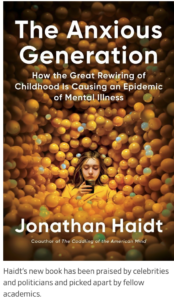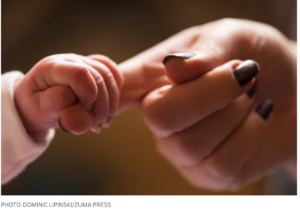
If you’re not comatose, you’ve probably noticed that most young people spend much of their time with their noses buried in their cell phones. Go to any restaurant in your area and spend a moment observing families not speaking to one another because the children, and sometimes the parents, are looking at their cell phones rather than having a conversation. We’ve become accustomed to this behavior, but in our hearts we know it’s wrong.
Now someone has finally come out and told us what we know is true. Peggy Noonan, writing for The Wall Street Journal, tells us about a new book by Jonathan Haidt called The Anxious Generation: How the Great Rewiring of Childhood is Causing an Epidemic of Mental Illness. Noonan says Haidt’s book has broken through and is clearing the way for parents’ groups and individuals to move forward together on an established idea – doing something about this widespread problem. Mr. Haidt is a widely admired social psychologist who teaches at New York University’s Stern School of Business. He has spent his career studying emotion, culture and morality, turning along the way to child development and adolescent mental health.
Noonan says, “What we all know is that there’s a mental-health crisis among the young, that they seem to have become addicted to social media and gaming, and that these two facts seem obviously connected. Mr. Haidt says, and shows, that the latter is a cause of the former.”
He tells the story of what happened to Generation Z, which he defines as those born after 1995. (They followed the millennials, born 1981-95.) Older members of Gen Z entered puberty while four technological trends were converging. One was the arrival of the iPhone in 2007, another the continuing spread of broadband internet. The third, starting in 2009, was “the new age of hyper-viralized social media,” with likes, retweets and shares. In 2010 came the front-facing camera on smartphones, which “greatly expanded the number of adolescents posting carefully curated photos and videos of their lives for their peers and strangers not just to see, but to judge.” This became “the first generation in history to go through puberty with a portal in their pockets that called them away from the people nearby and into an alternative universe that was exciting, addictive, unstable and . . . unsuitable for children and adolescents.”
Pew Research reports that, in 2011, 23% of teens had a smartphone. That meant they had only limited access to social media—they had to use the family computer. By 2016 one survey showed 79% of teens owned a smartphone, as did 28% of children 8 to 12. Soon teens were reporting they spent an average of almost seven hours a day on screens. “One out of every four teens said that they were online ‘almost constantly,’” Mr. Haidt writes. Girls moved their social lives onto social media. Boys burrowed into immersive video games, Reddit, YouTube and pornography.
The tidal wave came to these children during puberty, when the human brain is experiencing its greatest reconfiguring since early childhood. In puberty, as brain researchers say, “neurons that fire together, wire together.” What you do at that time “will cause lasting structural changes in the brain,” Mr. Haidt writes. Suddenly children “spent far less time playing with, talking to, touching or even making eye contact with their friends and families.” They withdrew from “embodied social behaviors” essential for successful human development. It left them not noticing the world.
You don’t have to be a doctor to understand all this leads to mental illness. Rates of mental illness among the young went up dramatically in many Western countries between 2010 and 2015. Between 2010 and 2024 major depression among teens went up 145% among girls, 161% among boys. There was a rise in disorders related to anxiety as well. Haidt says “The rate of self-harm for. . . young adolescent girls nearly tripled from 2010 to 2020.”
Naturally, parents had to make choices about how to respond to this situation. Haidt says parents over the past few decades made two big choices about how to keep children safe, and both were wrong. “We decided the real world was so full of dangers that children should not be allowed to explore it without adult supervision, even though the risks to children from crime, violence, drunk drivers, and most other sources have dropped steeply since the 1990s. At the same time, it seemed like too much of a bother to design and require age-appropriate guardrails for kids online, so we left children free to wander through the Wild West of the virtual world, where threats to children abounded.”
Mr. Haidt suggests four reforms:
- No smartphones before high school, only basic phones with no internet capability.
- No social media before 16. Let their brains develop first.
- All schools from elementary through high school should be phone-free zones—students can store their devices in lockers.
- Bring back unsupervised play. Only in that way will kids naturally develop social skills and become self-governing.
Florida Governor Ron DeSantis is already taking action along these lines to address this problem. On March 25th he signed new legislation which prohibits children under the age of 14 from becoming social media account holders and allows 14 and 15-year-olds to become account holders with parental consent. “Social media harms children in a variety of ways,” said the governor. “HB 3 gives parents a greater ability to protect their children.”
Who is to blame for this situation?
Near the end of the book, Haidt quotes Sean Parker, the first president of Facebook, on the inner thinking of the Silicon Valley pioneers who created this new world. In a 2017 interview Mr. Parker said they wished to “consume as much of your time and conscious attention as possible.” The “social validation feedback loop” they created exploits “a vulnerability in human psychology.” The apps need to “give you a little dopamine hit every once in a while, because someone liked or commented on a photo or a post or whatever. And that’s going to get you to contribute more content, and that’s going to get you . . . more likes and comments.” He said that he, Mark Zuckerberg and Kevin Systrom, a co-founder of Instagram, “understood this consciously. And we did it anyway.” He added: “God only knows what it’s doing to our children’s brains.” Now we all know.



